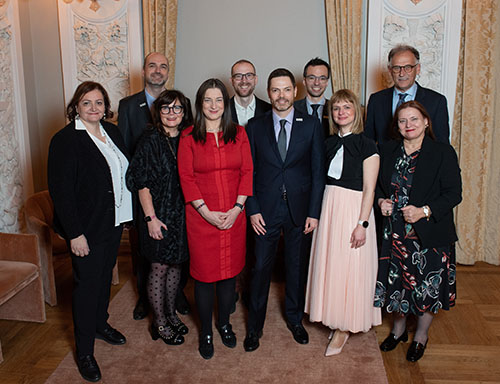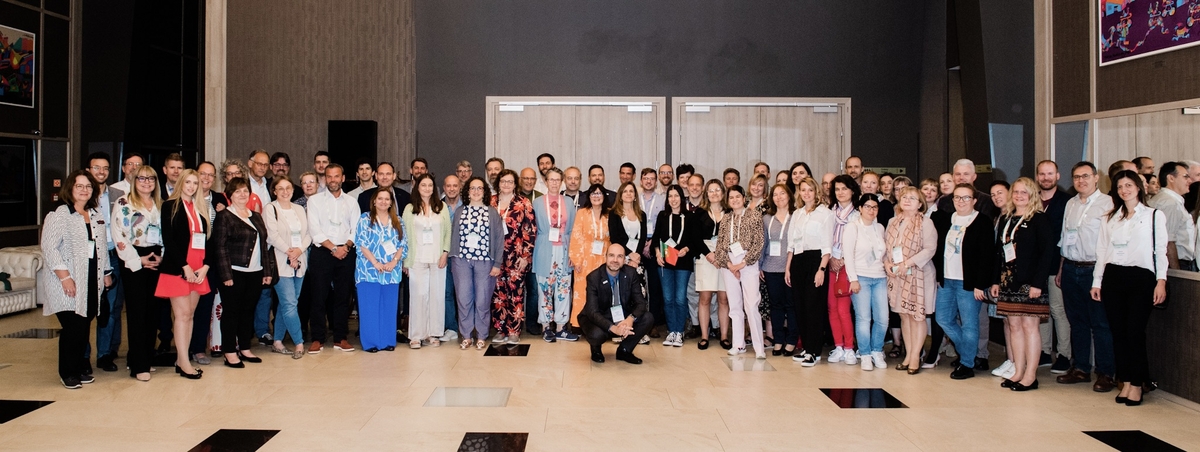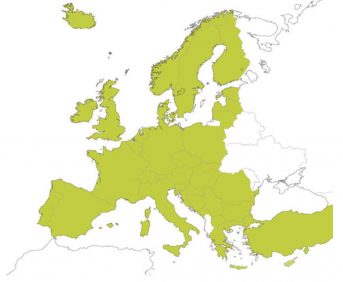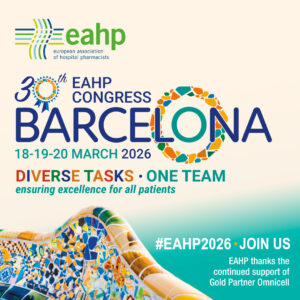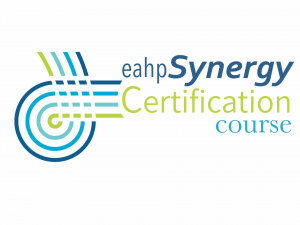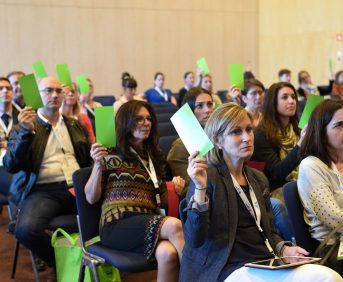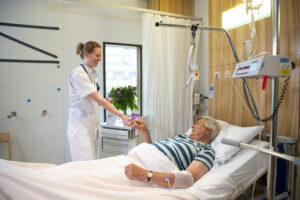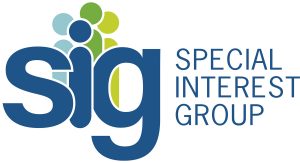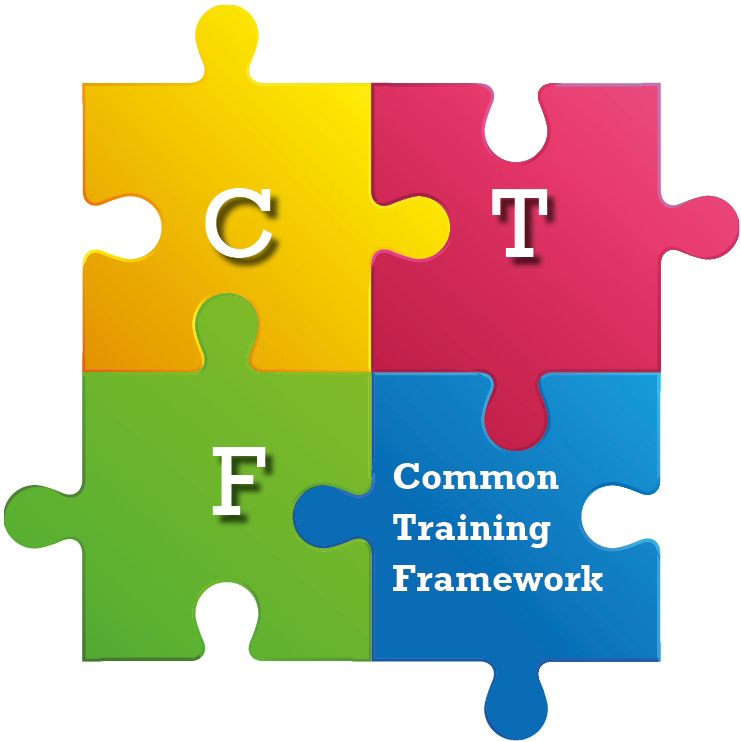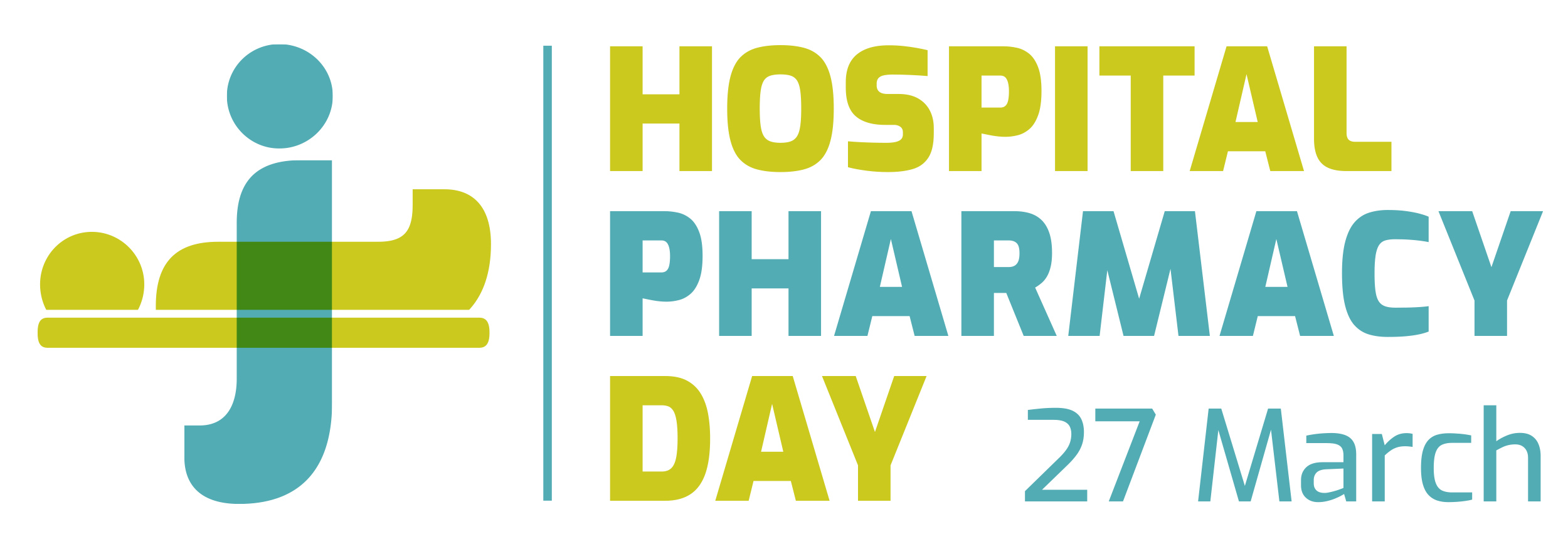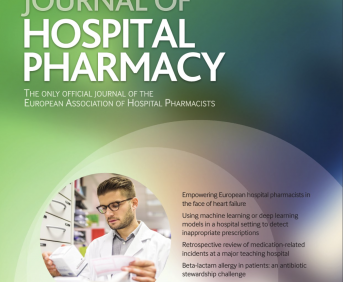PHARMACOGENETICS IS GROWING FAST
Pdf

European Statement
Clinical Pharmacy Services
Author(s)
Xando Díaz-Villamarín, Ana Pozo-Agundo, Paloma García-Navas, Celia Castaño-Amores, Alba Antunez-Rodriguez, Cristina Lucía Dávila-Fajardo
Why was it done?
Pharmacogenetics (PGx) has the potential to predict patient´s drug response. Many genetic polymorphisms have been associated with variable drug response. This has been demonstrated with the highest level of evidence in fact many of them have been included in clinical dosing guidelines such as those from the Dutch Pharmacogenomics Working Group (DPWG) and Clinical Pharmacogenetics Implementation Consortium (CPIC). Actually, many drug labels include the recommendation about genotyping specific single nucleotide polymorphisms (SNP) prior to drug prescription.
What was done?
We have implemented pharmacogenetic tests in our hospital for a total of nine drugs.
How was it done?
Our hospital provides a PGx test service according to the following workflow. Physicians order the PGx test to the Pharmacy Unit, we take a saliva sample with sterile-cotton tipped swabs and send them to the Genomic Unit at Genyo. There, we extract the DNA and genotype the variants of interest. Genetic results are reported back to the Pharmacy Unit within 48-72 hours. After genotype-phenotype-recommendation translation according to the CPIC and DPWG dosing guidelines, we upload the dosing recommendation as a PGx report to the electronic patient´s medical history.
What has been achieved?
Since 2012, 2414 patients have benefited from our PGx test service for at least one drug-gene interaction. These tests have been requested by seven hospital departments with regard to a total of nine different drugs. We have reported 932 PGx dosing recommendations: Clopidogrel with 2013 genotyped patients and 845 dosing recommendations; Azathioprine with 208 and 21; Capecitabine: 48 and 1; 5-FU: 5 patients without recommendations; Tamoxifen: 117 and 48; Trastuzumab: 34 and 15; Irinotecan: 4 and 2; Simvastatin/Atorvastatin: 2 genotyped patients and no recommendations.
What next?
Since the first PGx test in 2012, we have been able to implement PGx tests in daily clinical routine in our hospital affecting 9 drugs. 2414 patients have benefited from this service and we are working on the implementation of new polymorphisms affecting drug response to expand our services.
THE APPLICATION OF AN EHEALTH MODEL IN THE HEALTH CARE SYSTEM
Pdf

European Statement
Clinical Pharmacy Services
Author(s)
MAR GOMIS-PASTOR, ANNA DE DIOS LÓPEZ, MARIA ANTONIA MANGUES, MIRIAM ORS, MERITXELL CUCALA, CATERINA SANPOL, VICTOR ROBERT, XAVIER BORRAS, GEMMA CRAYWINCKEL
Why was it done?
HTP are therapeutically complex patients who may benefit from an intensive telematic follow-up. Moreover, human relations among patients and health providers may be enhanced to improve patients’ empowerment with their health care. Additionally, interdisciplinary eHealth projects lead to increased interaction among health providers, expanding advanced patient-centered care in healthcare systems.
What was done?
An eHealth program directed to heart transplant patients (HTP) was implemented. The software developed was called mHeart and consists on a mobile phone application complemented by a website(https://n9.cl/ajut). A pilot study to validate the software and a clinical trial were conducted. This tool is now extended into clinical practice.
How was it done?
This project and its potential scalability has achieved the creation of a well-established framework involving among relevant others the Legal Department, the Information Systems Department, the patient data protection supervisor, and the Innovation Research Institute.
The success and the scalability of these innovative projects in our centre depended on health providers’ engagement with eHealth, new interoperability solutions, adequate institutional support, and government reimbursement models.
What has been achieved?
The clinical trial conducted in 134HTP has demonstrated to improve recipients’ adherence to immunosuppressants (85% mHeart follow-up vs 46% conventional follow-up)[OR=6.7 (2.9;15.8),P-value=.000], to improve patients’ experience of therapeutic regimens and to reduce in-clinic facilities because the mHeart follow-up. (65% mHeart follow-up vs 35% conventional follow-up)[OR=3.4 (1.7;6.9),P-value=.001].
What next?
This eHealth experience has allowed continuing creating evidence on the use of the eHealth in other populations: an onco-hematological platform, EMMA(Ehealth Medical self-Management Aid), has been designed including diverse profiles depending on the clinical specifications (e.g. multiple myeloma or bone marrow transplant conditions); MyPlan has been adapted to perform an interdisciplinary follow-up of any multimorbid population with polypharmacy. Thus, the system can be used in any multimorbid patients by activating or omitting certain modules that define the target patients’ specific comorbidities (e.g. glycemia module or blood pressure module).
The new EMMA and MyPlan will be clinically tested in diverse trials in 2020 including several health care interdisciplinary teams, including the emergency setting, onco-hematology, migraine, dyslipidemia and cardiovascular risk, among relevant others. In addition, other Spanish centers are implementing the eHealth model and the software in their Institutions assisted by the experience gathered.
Impact of an Integrated Medicines Optimisation Pharmacist (IMOP) on Biosimilar Uptake in the Mater Misericordiae University Hospital
Pdf

European Statement
Clinical Pharmacy Services
Author(s)
Grainne Johnston, Jennifer Brown
Why was it done?
The High Tech Scheme (HTS) in Ireland facilitates access to high cost drugs with proven cost benefit for patients. Combined national expenditure on adalimumab (Humira®) and etanercept (Enbrel®) exceeded €190 million in 2017. Biosimilar versions of both drugs are available, however largely not utilised. The most cost effective options for each drug were designated as the Best Value Biologic (BVB). Prescribing a BVB option offers the opportunity to save a considerable amount of money for the state.
What was done?
The Mater Misericordiae University (MMUH) Integrated Medicines Optimisation Pharmacist (IMOP) provided education and removed barriers to initiate biosimilar prescribing of adalimumab and Enbrel in the MMUH.
How was it done?
The MMUH IMOP was delegated to assist with implementation of BVBs prescribing.
The MMUH IMOP generated Patient Information Leaflets in relation to BVB switching.
The IMOP reviewed out-patients currently prescribed Humira® or Enbrel®, and provided education and information on switching from the originator to the BVB
What has been achieved?
Prior to the IMOP intervention, no patients in the MMUH had been prescribed a BVB.
Following IMOP intervention, between June 26 and September 27, 2019:
• 291 Humira® or Enbrel® patients were scheduled to attend MMUH rheumatology, gastroenterology and dermatology clinics.
• Of these, 64% (n=185) were switched to a BVB. An additional 19 patients were newly commenced on a BVB.
• The IMOP educated and counselled 91% (n=92), 93% (n=53) and 48% (n=13) of patients switched to a BVB in rheumatology, gastroenterology and dermatology respectively.
The largest contributing factor identified for patients not being prescribed a BVB was, no review by the IMOP prior to medical review; 65% (n=35), 59% (n=10) and 86% (n=12) for rheumatology gastroenterology, and dermatology respectively.
What next?
BVB prescribing can save vital health funds for the state while maintaining patient care. The MMUH IMOP is now progressing to adopt BVB prescribing for a number of other biological medicines at significant savings for the MMUH and state.
DESIGN AND IMPLEMENTATION OF A TELEPHARMACY PROTOCOL IN A THIRD LEVEL HOSPITAL DURING THE CORONAVIRUS PANDEMIC
Pdf

European Statement
Clinical Pharmacy Services
Author(s)
YLENIA JIMÉNEZ LÓPEZ, MARIA ISABEL SIERRA TORRES, ENCARNACIÓN PÉREZ CANO, JUAN JEREZ ROJAS, CARMEN LUCÍA MUÑOZ CID, RAQUEL CLARAMUNT GARCÍA
Why was it done?
After the declaration of the national state of alarm due to the COVID-19 crisis, the Outpatients Pharmaceutical Care Unit detected the need to design a telepharmacy protocol.
This protocol was established with the aim of avoiding patient vistis to PS, thus reducing the risk of outbreaks originated in the hospital.
Since March 19, 2020, the protocol has been implemented with no interruption.
What was done?
Due to SARS-CoV-2 pandemic situation, we developed a telepharmacy protocol for the outpatients of a Pharmacy Service (PS).
How was it done?
Circuit and stages:
1. Selecting patients candidates for telepharmacy, who were those with an appointment for collecting medication in the PS and had no other appointment within the hospital (with the doctor or for treatment administration).
2. Contacting with the patient or the caregiver via telephone to verify treatment adherence and the delivery data and place.
3. Packaging, highlighting the correct identification data and storage conditions.
4. Notifying to the delivery company.
This protocol was agreed by the PS, the hospital management and physicians involved.
The system was designed, in the first place, so that treatments were delivered by courier service to the patients’ addresses. Finally, due to logistic and economic problems, it was modified to make delivery through pharmacy offices (PO).
What has been achieved?
6.068 treatments have been delivered from 19/03/2020 to 30/09/2020: an average of 47 shipments per day.
In the 6068 shipments, there have been:
• 722 (11,9%) delivered through an external company (19 / 3-20 / 4/20)
• 756 (12,5%) delivered by the local courier (19 / 3-29 / 4/20)
• 4590 (75,6%) delivered through PO (8 / 4-30 / 9/20)
During this whole period, 14.496 patients (including telepharmacy) have been attended in the PS. The 6.068 deliveries mean that we have avoided 42% of hospital visits, thus minimizing the risk related to the pandemic.
The change in the delivery system has meant a cost reduction from 10.000 €/month with the first system to 0 €/month with the pharmacy office system.
What next?
Our telepharmacy protocol is still active. We keep working on ways to improve the communication with patients and increase the number of telecare services.
DELIVERY OF SPECIALISED MEDICINES IN MEDICINE POST BOXES – A PILOT STUDY
Pdf

European Statement
Clinical Pharmacy Services
Author(s)
Maja Kirstine Brøns, Gitte Borup
Why was it done?
The purpose was to move medicine collection from the outpatient clinics to a MPB in order to reduce CO2-emission, due to less kilometers traveled by patients, to increase equal access to healthcare services, and to reduce physical patient contact during a global pandemic.
What was done?
This was a pilot study that investigated a method for, and patient satisfaction with, delivery of specialized cost-free hospital medicines via Medicine Post Boxes (MPB) in rural areas.
How was it done?
The project was initiated by clinical pharmacists, who acted as interdisciplinary liaisons, who understood the clinical aspect of the medical treatment, the importance of good distribution practice and the logistic capacity at the hospital pharmacy. Having completed clinical controls via telephone, the clinic forwarded the information needed to the hospital pharmacy. Initially, all requisition forms were checked by clinical pharmacists to ensure complete information was given, and that documentation was performed properly. Once fully implemented, a task shifting onto pharmaconomist was done concerning the control of the requisitions, however initiation of cooperation and problem solving with the clinic was maintained as a pharmacist task.
What has been achieved?
Focus group interviews with doctors and nurses from the clinics expressed satisfaction with the flexibility of conducting clinical controls over the phone, and not having to handle the practical part of ordering, documenting and handing out medicines. No concerns of patient safety were expressed, and a wish for full coverage for medicine delivery via MPB was stated. A survey among the patients using the MPB was conducted: A total of 148 respondent participated of whom 98 % stated being ’very pleased’ or ’pleased’ with the service. Also, 98 % felt safe to ’a very high degree’ or ’high degree’ with using the MPB and 99 % wished to use the MPB again. Estimates of CO2 reduction have not yet been calculated.
What next?
MPB’s should be available in urban areas also, as it increases flexibility for the patients and healthcare professionals. The goal is to include all suitable clinics and patients who receive long term treatment with hospital medicines
PANDEMIC CRISIS COVID 19: THE DRUGS HOME DELIVERY AS A TOOL FOR ADHERENCE AND COMPLIANCE
European Statement
Clinical Pharmacy Services
Author(s)
BARBARA RE, MARTA DEL VECCHIO, CLAUDIA LAURIA PANTANO, ELIROSA MINNITI , VITO LADISA
Why was it done?
The covid-19 pandemic and the lockdown made it difficult and very often not possible to access hospital pharmacies for dispensing of drugs for cancer treatment
What was done?
Drugs homedelivery has been implemented for fragile patients and at risk both oncological and hemato-oncological, all over the italian territory
How was it done?
Through the telemedicine program, in agreement with the oncologist, patients unable to reach the pathology doctor’s office are contacted and the project explained to them. If the patient accepts the delivery at home, paths with specialized couriers have been activated, in compliance with the GDPR, which ensure the delivery of medicines within 48 hours. Upon delivery The Pharmacist contacts the patient to ensure that they have been received the medicines and reinforces how you take the drug and the potential side effects that need to be reported to doctor and / or pharmacist
What has been achieved?
In the period from March to September 2020, 501 deliveries were made, of which 301 in the regional territory and 200 in the national territory. 423 patients were contacted, A Customer Satisfaction was activated to which 90% of patients with a high degree of acceptance of the service responded
What next?
The Homedelivery service has shown that integrating telemedicine, with the collaboration oncologist and pharmacist, allows, when possible, to avoid fragile patients having to go to the hospital every month to collect the drug needed for their treatment. Furthermore, the role of the pharmacist will be increasingly central in the home clinical management of this patient population to assure Adherence and Compliance even in at Home setting.
DEFINING DOSAGE REGIMENS OF ERLOTINIB AND GEFITINIB IN NON-SMALL CELL LUNG CANCER PATIENTS USING MODELLING AND SIMULATION (submitted in 2019)
Pdf

European Statement
Clinical Pharmacy Services
Author(s)
SOFIA KONSTANTINIDOU, VANGELIS KARALIS
Why was it done?
Tyrosine kinase inhibitors (TKIs), like erlotinib and gefitinib, are widely used in anticancer therapy. However, after long term administration of TKIs, resistance is observed in the majority of patients. Thus, it is necessary to be able to define individualised dosage regimens for TKIs in cancer patients. Nowadays, modelling and simulation approaches represent the most powerful tool in the hands of clinical pharmacists towards precision medicine.
What was done?
Population pharmacokinetic (PK) – pharmacodynamic (PD) modelling was utilised to simulate erlotinib and gefitinib dosage regimens for non-small cell lung cancer. In silico clinical trials with virtual patients, of several resistance levels, were simulated in order to optimise pharmacotherapy and get better therapeutic outcomes.
How was it done?
The utilised PK/PD model and average parameter values were obtained from the study of Eigenmann and colleagues. This model was fully validated using statistical criteria and goodness of fit plots. In order to simulate many possible conditions that may occur in clinical practice, several different values of erlotinib and gefitinib clearance, absorption rate, pharmacodynamic characteristics (like tumor volume), and resistance were assessed. In addition, several dosage schemes were simulated. The entire modelling work was performed in Monolix® 2019R1.
What has been achieved?
Concentration vs. time and effect vs. time plots for the virtual patients were simulated for a variety of conditions and tumour resistance levels. For both TKIs, decrease of body clearance led to higher plasma concentrations, as well as more intense and longer duration of the effect (i.e. tumour volume shrinkage). Enhanced drug effect on resistant cells resulted in a decrease in tumour volume. In addition, a variety of concentration-time profiles were simulated, making it possible to choose the best regimen for each patient.
What next?
In this study, the use of modelling techniques led to the simulation of many conditions of patients and adjustment of dosage regimens according to their needs. Wider application of in silico methods using virtual patients will allow the design of the most appropriate individualised dosage schemes tailored to the patients’ requirements.
IMPACT OF PLANTS ON ANTICANCER DRUGS METABOLISM: DEVELOPMENT OF A DATABASE TO FACILITATE THE PHARMACIST’S EXPERTISE (submitted in 2019)
Pdf

European Statement
Clinical Pharmacy Services
Author(s)
ANAIS AMAR, SIMON CLAUTRIER, MORGANE GIOVANELLI, REGINE CHEVRIER
Why was it done?
The phytotherapy market has continued to grow for several years. However, in oncology, concomitant use of plants with oral or injectable chemotherapies can be harmful. Plants can interact with many cytochromes (CYP), impacting on the biotransformation and kinetics of drugs. While grapefruit or St John’s wort are already recognised as interfering with many therapies, the impact of many plants remains unknown for healthcare professionals. Tools exist to evaluate their effects on drug metabolism, but the multiplication of sources delays and complicates the advice of pharmacists.
What was done?
Centralise information on plant metabolism on a single support by creating a database. Facilitate pharmacist’s expertise about interactions between plants and anticancer drugs.
How was it done?
To create the database, it was necessary to establish an exhaustive list of plants. Three sources of information have been used:
– Inventory of phytotherapy products marketed in 4 drugstores
– Census of plants consumed by patients seen in pharmaceutical consultation (PC)
– Consultation of websites specialized in phytotherapy
Then, an Excel table has been developed:
– each line corresponds to a plant
– each column corresponds respectively to 17 CYP, a transport protein (Pgp), estrogen-like (EL) and antioxidant (AO) properties of the plant.
A colour code has been defined according to the inhibitory (yellow), inductive (blue), EL (purple) and AO (red) action of the plant. If there is no interaction, the box remains blank.
Plant effects data were collected from Hedrine®, Oncolien®, MSKCC, RX list and Drugs.com websites.
What has been achieved?
Finally, 174 plants have been accounted in drugstores, 82 were identified during PC and 129 found on websites. If 10% of plants have an EL action and 16% an AO effect, approximately 30% have inductive and/or inhibitory action of at least one CYP and/or PgP. Since the tool’s creation: 91% of answers could be given immediately to patients compared to only 9% delayed (plants still unreferenced).
What next?
This database is an essential tool for answering questions from patients with anticancer drugs. It saves precious time and responsiveness during PC, but also during patient phone calls. However, critical work with divergent information between sources is to be expected. Currently, as a precaution, we don’t recommend the use of plants subject to such a contradiction.
ONCOLOGY PHARMACISTS: EXPANDING OUTPATIENT SERVICE MODELS TO INCREASE PATIENT IMPACT AND SAFETY (submitted in 2019)
European Statement
Clinical Pharmacy Services
Author(s)
Paul Firman, Karen Whitfield, Therese Hayes
Why was it done?
The provision of outpatient oncology services by pharmacists is still limited, but this role is an emerging one. There is limited literature to date that suggests that pharmacists can add value while satisfying the needs of patients with cancer, addressing medication use and symptoms, and potentially generating revenue for the practice. The value that clinical pharmacists can bring to outpatient clinics other than oncology clinics has been highlighted extensively, providing added weight to the argument for incorporating these professionals into the cancer care model.
What was done?
The oncology pharmacy team in a tertiary referral hospital with the assistance of activity-based funding commenced an outpatient clinic allowing patients an opportunity for medication reviews, appropriate counselling of oral chemotherapy and discussion of medication side effects which was a gap within the current service.
How was it done?
In consultation with pharmacy, medical, nursing and administrative staff a working party was formed to establish the outpatient pharmacy clinic. Factors including patient cohort, appointment scheduling, clinic room availability, referral methods, and key performance indicators were discussed. The group met monthly to discuss the progression of the clinic and any barriers.
What has been achieved?
Over the first 3 months (January – March 2019) 215 patients on an average of 7.5 medications were reviewed. Within the cohort 57% of the patients were taking high risk medications (known as PINCHA medications) and 37% received counselling on new medications. There were 37 medication interventions mostly involving drug−drug interactions and medication optimisation. For succession planning, pharmacist training has also occurred.
What next?
Outpatient oncology practice is a growing area of opportunity for pharmacists to provide clinical services as part of a multidisciplinary team. This is of benefit both to the multidisciplinary team and the patient, ensuring the best possible outcomes. With the growing complexity of oncology treatments, the pharmacist’s role is vital to ensure quality use of medicines, safety and patient centred care. Training is currently being undertaken to expand the role and to ensure continuity of the service.
CENTRALISED ONLINE REGISTRY FOR PATIENT WITH METASTATIC COLORECTAL CANCER TREATED WITH REGORAFENIB (submitted in 2019)
Pdf

European Statement
Clinical Pharmacy Services
Author(s)
Vanesa Alonso Castro, Beatriz López Centeno, Daniele Alioto, Angela Gil Martin, Ignacio Martin Casasempere, Maria Segura Bedmar, Ainhoa Aranguren Oyarzábal, Maria Jose Calvo Alcántara
Why was it done?
The European Society for Medical Oncology (ESMO) has developed the ESMO-Magnitude of Clinical Benefit Scale (ESMO-MCBS) to assess the magnitude of clinical benefit for cancer medicines. In the CORRECT trial, regorafenib has an ESMO-MCBS score of 1 (questionable benefit). It is necessary to assess the effectiveness and safety of regorafenib treatment in real clinical practice.
What was done?
To describe the implementation of a centralised registry (CR) for all patients with metastatic colorectal cancer (mCRC) being treated with regorafenib in a Regional Health Service (RHS).
How was it done?
A working team including oncologists, hospital pharmacists and RHS professionals developed the CR for patients with mCRC starting treatment with regorafenib in 2019. The variables selected were: age, sex, ECOG, primary tumour location, number of metastatic sites, presence of liver or brain metastases, RAS-mutation status, BRAF-mutation status, previous lines, follow-up variables (dose, type of response and adverse events), date and reason for withdrawal.
What has been achieved?
The CR is available for all professionals in the RHS in April 2019 and it is compulsory to include all patients starting treatment in 2019. Forty-nine patients were included (59.2% males). The median age was 68 years. The baseline characteristics of the patients were: − 36.7% and 63.3% of patients had ECOG 0 and 1 respectively; − 79.4% had the primary tumour in the left colon; − 36.7% had 3 or more metastatic sites; −71.4% and 2.0% had liver and brain metastases respectively; − RAS gene was mutated in 57.1% of patients and undetermined in 2.0%; − BRAF gene was mutated in 4.1% of the patients and undetermined in 34.7%; −in 65.3% of patients regorafenib was the fourth line or later therapy. With median treatment duration of 2.5 months, 42.9% of patients had discontinued treatment: 30.6% had progressive disease, 8.2% had adverse events and 4.1% had died.
What next?
The experience obtained with this registry has allowed us to know the use profile of this drug in all hospitals of RHS. A comprehensive assessment of the collected data and a longer follow-up period are necessary to assess the effectiveness and safety of regorafenib treatment in real clinical practice.
